
The Legion of Super-Heroes is a superhero team appearing in American comic books published by DC Comics. Created by writer Otto Binder and artist Al Plastino, the Legion is a group of superpowered beings living in the 30th and 31st centuries of the DC Comics Universe, and first appeared in Adventure Comics #247.
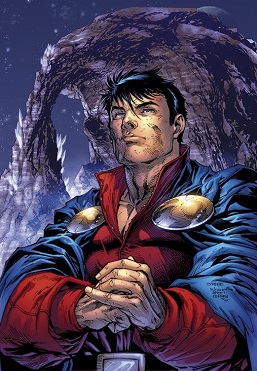
Lar Gand, known mainly as Mon-El, is a superhero appearing in American comic books published by DC Comics, commonly in association with the Legion of Super-Heroes, Superboy, and Superman. The character has been reinterpreted over the years, but in all versions serves as a hero with abilities similar to those of Superman, sometimes serving as a substitute for him.

Brainiac 5 is a superhero appearing in comics published by DC Comics. He is from the planet Colu and is a long-standing member of the Legion of Super-Heroes in the 30th and 31st centuries.
The Legion of Super-Villains is a team of supervillains who appear in comic books published by DC Comics, primarily as enemies of the Legion of Super-Heroes. They first appeared in Superman #147.
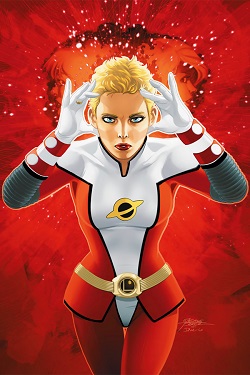
Saturn Girl is a superheroine appearing in comics published by DC Comics. A talented telepath from the 30th century, Saturn Girl is a founding member of the Legion of Super-Heroes. Imra's "Saturn Girl" title refers to her homeworld of Titan, Saturn's largest moon. There have been three versions of Imra since her original debut, separated by the events of the limited series Zero Hour: Crisis in Time! and Infinite Crisis.
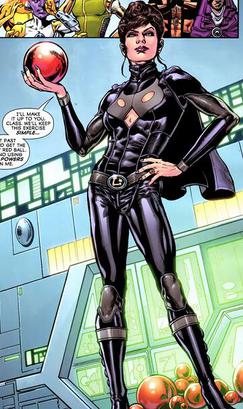
Night Girl is a fictional character appearing in media published by DC Comics, primarily as a member of the Legion of Super-Heroes and Legion of Substitute Heroes in the 30th and 31st centuries. She first appeared in Adventure Comics #306.

Rene Jacques "R. J." Brande is a character appearing in DC Comics, primarily in association with the Legion of Super-Heroes. He first appeared in Adventure Comics #350, and was created by E. Nelson Bridwell.

Legion of Super Heroes is an American animated television series produced by Warner Bros. Animation, adapted from the DC Comics series of the same name. It debuted on September 23, 2006, and centers on a young Superman's adventures in the 31st century, fighting alongside the eponymous group of superheroes. The show was produced by one of its main character designers James Tucker, a co-producer of the Justice League Unlimited series, for the Kids' WB line-up on The CW network.
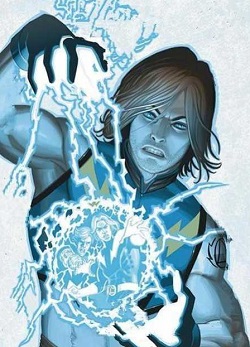
Garth Ranzz, also known as Live Wire and Lightning Lad, is a superhero appearing in media published by DC Comics, usually those featuring the Legion of Superheroes, a 30th and 31st century group of which he is a founding member. He has the superhuman ability to generate electricity, usually in the form of lightning bolts.
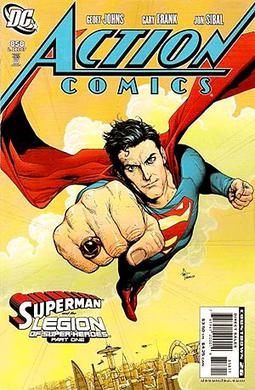
"Superman and the Legion of Super-Heroes" is a 2007 comic book DC Comics story arc written by Geoff Johns, illustrated by Gary Frank, which features the character Superman and the return of the pre-"Crisis on Infinite Earths" Legion of Super-Heroes. It ran in Action Comics #858–863, this arc marked Geoff Johns' debut as a solo writer on Action, having previously written alongside Kurt Busiek and Richard Donner.

Superboy's Legion is a two-issue comic book mini-series, published by DC Comics cover dated February and March 2001, under the Elseworlds imprint. Written by Mark Farmer, with art by Farmer and Alan Davis. The comic series is a tale about the baby Kal-El, the last survivor of the doomed planet Krypton, arrives on Earth in the 30th century and is found by billionaire R.J. Brande. As Kal grows up, he decides to find other super-powered teens like himself and form a Legion of Super-Heroes. The story uses elements from the Silver Age Comics, most notably the original Legion of Super-Heroes series.

"The Great Darkness Saga" is a five-issue American comic book story arc featuring the Legion of Super-Heroes. It was written by Paul Levitz, with art by Keith Giffen and Larry Mahlstedt. Published by DC Comics in 1982, the arc first appears in Legion of Super-Heroes vol. 2, #290–294. It is notable for featuring appearances by virtually every living past and present Legionnaire as of 1982, as well as most of the team's 30th-century allies, including the Legion of Substitute Heroes, the Wanderers, the Heroes of Lallor, and the 20th-century Kryptonian refugee Dev-Em. The heroes battle an immensely powerful being shrouded in darkness, ultimately revealed to be the ancient ruler of Apokolips, Darkseid.
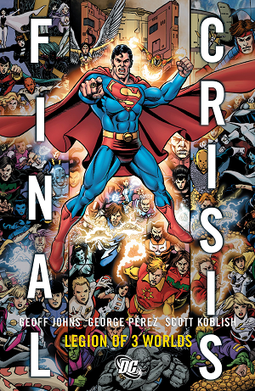
Final Crisis: Legion of 3 Worlds is a five-issue 2008 limited series produced by DC Comics. The series is a tie-in to Final Crisis. It is scripted by Geoff Johns, and drawn by George Pérez.
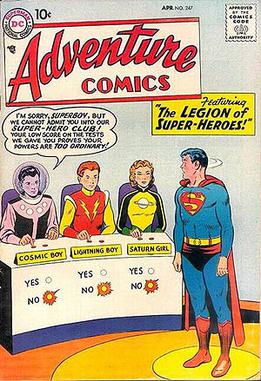
The 1958 version of the Legion of Super-Heroes is a fictional superhero team in the 31st century of the DC Comics Universe. The team is the first incarnation of the Legion of Super-Heroes, and was followed by the 1994 and 2004 rebooted versions. It first appeared in Adventure Comics #247 and was created by Otto Binder and Al Plastino.
"The Greatest Hero of Them All" is a story arc that was published by DC Comics, and presented in Superman vol. 2, #8, Action Comics #591, and Legion of Super-Heroes vol. 3, #37–38 from August through September 1987. It was written by Paul Levitz and John Byrne, and pencilled by Byrne, Greg LaRocque and Mike DeCarlo. The story arc was DC’s first attempt to correct the inconsistencies in Legion history created when the original Superboy was removed from mainstream DC continuity in the Man of Steel limited series.
"End of an Era" is an American comic book story arc that was published by DC Comics, and presented in Legion of Super-Heroes vol. 4, #60-61, Legionnaires #17-18, and Valor #22-23. It was written by Mark Waid, Tom McCraw and Kurt Busiek, with pencils by Stuart Immonen, Ron Boyd, Chris Gardner and Colleen Doran. A tie-in to the Zero Hour: Crisis in Time miniseries, it is the final story arc in the Legion of Super-Heroes' original timeline, and marks the end of 36 years of unbroken Legion continuity.
"The Adult Legion" is a comic book story arc published by American company DC Comics, presented in Adventure Comics #354-355. It was written by Jim Shooter, pencilled by Curt Swan and inked by George Klein. The story arc features one of Superman's encounters with the Legion of Super-Heroes as adults, and foreshadows several plot twists which occur in the years that follow.
Legionnaires 3 is a four-issue comic book limited series published by DC Comics in 1986, the second limited series to feature the Legion of Super-Heroes. It was written by Keith Giffen and Mindy Newell, pencilled by Ernie Colón, and inked by Karl Kesel. The series pits the Legion's three founders against one of their deadliest enemies, the Time Trapper.
"The Exaggerated Death of Ultra Boy" is a comic book story arc published by American company DC Comics, presented in Legion of Super-Heroes vol. 2, #273–275 and #277–282. It was written by Gerry Conway, Roy Thomas, and Paul Levitz, with pencils by Jimmy Janes and Steve Ditko. It depicts the long odyssey of Ultra Boy, who is incorrectly presumed to be slain in battle.

Ol-Vir is a supervillain appearing in media published by DC Comics. He first appeared in Legion of Super-Heroes #294, and is often depicted as a member of the Legion of Super-Villains.

















